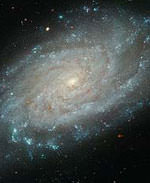
Image credit: Hubble
The latest image released from the Hubble Space Telescope is of the spiral galaxy NGC 3370, located in the constellation Leo. The galaxy was imaged because astronomers wanted to observe Cepheid variable stars – special stars which brighten and dim at a known rate and are used to calculate distances to objects. The team had to make a long exposure of the galaxy (about a full day), so Hubble had a chance to gather a lot of light; that’s why there are many fainter galaxies visible in the background of the picture.
Amid a backdrop of far-off galaxies, the majestic dusty spiral, NGC 3370, looms in the foreground in this NASA Hubble Space Telescope image. Recent observations taken with the Advanced Camera for Surveys show intricate spiral arm structure spotted with hot areas of new star formation. But this galaxy is more than just a pretty face. Nearly 10 years earlier NGC 3370, in the constellation Leo, hosted a bright exploding star.
In November 1994, the light of a supernova in nearby NGC 3370 reached Earth. This stellar outburst briefly outshone all of the tens of billions of other stars in its galaxy. Although supernovae are common, with one exploding every few seconds somewhere in the universe, this one was special. Designated SN 1994ae, this supernova was one of the nearest and best observed supernovae since the advent of modern, digital detectors. It resides 98 million light-years (30 megaparsecs) from Earth. The supernova was also a member of a special subclass of supernovae, the type Ia, the best tool astronomers have to chart the growth rate of the expanding universe.
Recently, astronomers have compared nearby type Ia supernovae to more distant ones, determining that the universe is now accelerating in its expansion and is filled with mysterious “dark energy.” Such measurements are akin to measuring the size of your room by stepping it off with your feet. However, a careful measurement of the length of your foot (to convert your measurements into inches or centimeters) is still needed to know the true size of your room. Similarly, astronomers must calibrate the true brightness of type Ia supernovae to measure the true size and expansion rate of the universe.
The very nearest type Ia supernovae, such as SN 1994ae, can be used to calibrate distance measurements in the universe, because other, fainter stars of known brightness can be observed in the same galaxy. These stellar “standard candles” are the Cepheid variable stars, which vary regularly in brightness with periods that are directly related to their intrinsic brightness, and thus allow the distance to the galaxy?and the supernova?to be determined directly. However, only the Hubble Space Telescope, equipped with its new Advanced Camera for Surveys, has the capability to resolve these individual Cepheids.
Adam Riess, an astronomer at Space Telescope Science Institute in Baltimore, Md., observed NGC 3370 a dozen times over the course of a month and has seen many Cepheid variables. Already he and his colleagues can see that these Cepheids are the most distant yet observed with Hubble. Because of their need to observe this galaxy with great frequency to record the variation of the Cepheids, the total exposure time for this galaxy is extremely long (about one full day), and the combined image provides one of the deepest views taken by Hubble. As a result, thousands of distant galaxies in the background are easily discernable.
Dr. Riess imaged NGC 3370 with Hubble in early 2003. His science only required looking at NGC 3370 in two filters that covered the visual and infrared portions of the spectrum. By teaming up with the Hubble Heritage Project, a third blue filter was added to the data to produce the composite three-color image that is shown.
Credit: NASA, The Hubble Heritage Team and A. Riess (STScI)
Source: Hubble Press Release
